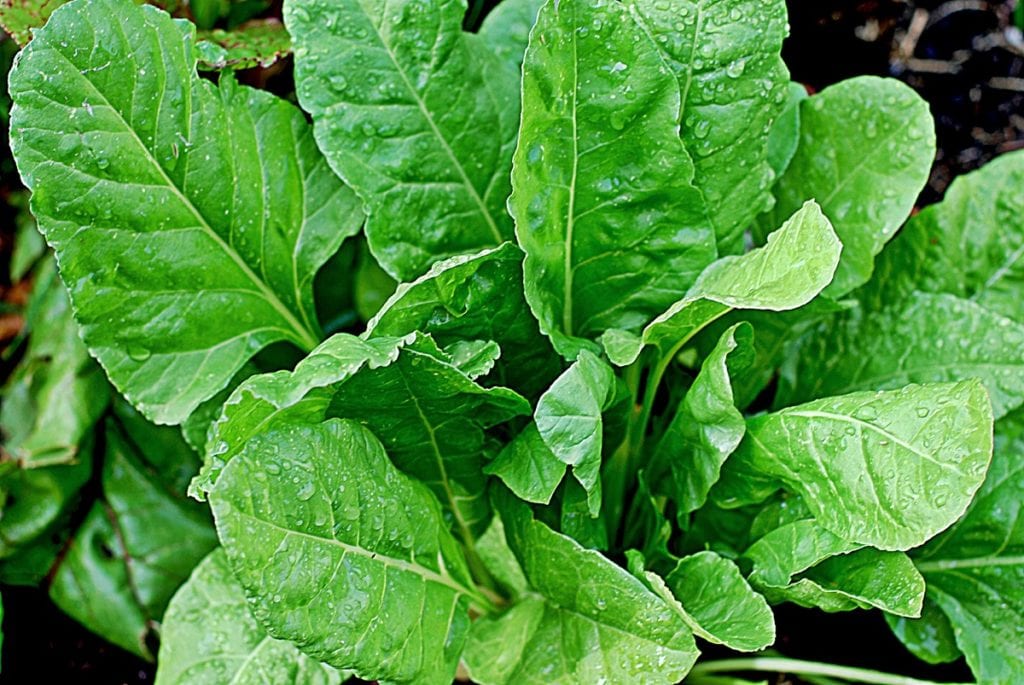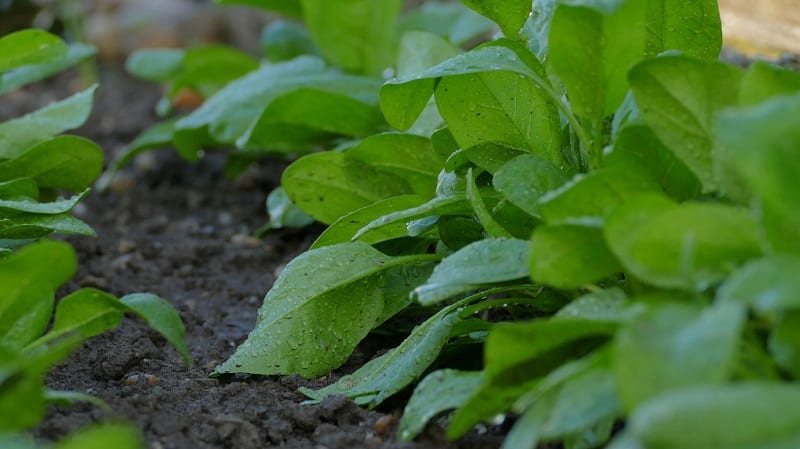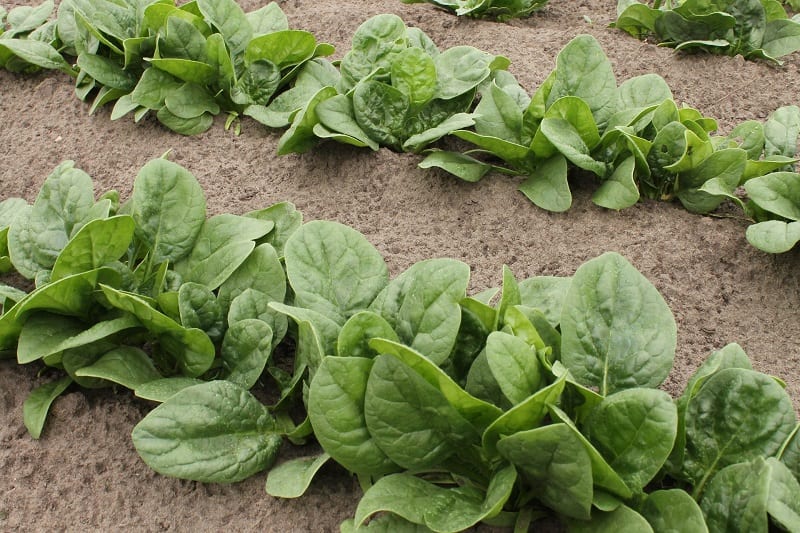Last Updated on May 5, 2025 by teamobn
Spinach is one of the most nourishing cool-weather crops to grow, yielding vitamin-rich, dark green leaves that are excellent for salads and cooking. You can also harvest spinach continuously once its leaves are a good size to encourage new growth.
Knowing how to grow spinach grants you a versatile kitchen ingredient you can use for soup and other dishes. Check out our grow guide below!

How to Grow Spinach
Contents
Experienced gardeners will make small, frequent plantings during late spring and summer. This allows them to concentrate on fall as the season for the main spinach crop.
Below are a few tips on how to grow spinach in your backyard.
Planting Spinach
Spinach planting starts with strong soil prep. Healthy soil helps seeds sprout into sturdy seedlings.
Preparing Nutrient-Rich Soil
Spinach thrives in soil that is moist and rich in organic matter. You should loosen the ground at least a foot deep before planting. A garden fork or tiller will break up compacted clay. After tilling, mix in three to four inches of well-rotted compost or aged manure.
These amendments boost nitrogen and improve drainage. Rake the bed level and remove large rocks or roots. Then lightly firm the soil surface to ensure even seed contact. Firm seedbeds help prevent seeds from washing away in heavy rain.
Timing Your Planting
You can begin sowing spinach seeds as early as six weeks before the last frost date. Early planting gives plants time to develop before heat arrives. Look for soil temperatures between 45°F and 75°F for optimal germination. A soil thermometer will guide you. In regions with mild winters, sow seeds in late summer for a fall and winter harvest. Prepping soil in autumn lets you drop seeds in barely thawed ground come early spring. Avoid planting when soil is waterlogged. Wet ground can lead to seed rot and poor growth.
Proper Seed Depth and Spacing
Seeds sown at the right depth and spacing make thinning easier later. Plant spinach seeds about half an inch below the soil surface. Space seeds two inches apart in rows that are 12 to 18 inches apart. After sowing, lightly firm the soil with your hands or a plank to secure seeds. Water gently to settle soil around seeds. Thin seedlings when they reach the two-leaf stage. Keep the strongest plants at least four inches apart. Proper spacing gives roots room to grow deeply.
Leveraging Shade Planting
In warm climates, planting spinach in the shade of taller crops prevents heat stress. Tall plants like corn, beans or sunflowers cast cooling shadows. Position your spinach rows on the north side of these crops. This shade protects young leaves from hot afternoon sun. You can also drape lightweight shade cloth over the rows when temperatures climb above 75°F. Monitor soil moisture under shade. Shaded plants need less frequent watering. Proper shade delays bolting and extends harvest seasons in warmer regions.

Caring for Spinach
Caring for spinach starts with simple steps that keep young plants healthy. Consistent attention helps you avoid bolting and promotes tender, flavorful leaves.
Thinning and Spacing
Overcrowded beds stunt growth and push spinach to seed too soon. After seedlings reach two true leaves, thin them so they sit four to six inches apart. Proper spacing improves air circulation and reduces disease pressure. This step is key to how to grow spinach evenly and vigorously. Leave the strongest-looking plants and gently remove extras at soil level to avoid disturbing roots. A well-spaced patch also makes harvesting easier and extends your picking window.
Nutrient Boosts
Spinach thrives when fed regularly. Once plants have developed four to six leaves, apply a nitrogen-rich feed. Compost tea or diluted fish emulsion works well. Pour the mixture around the base, avoiding direct contact with leaves to prevent burn. Repeat feeding every three to four weeks. Good nutrition supports steady growth and helps you master how to grow spinach throughout the season. For long, cool springs, side-dress with compost midseason to maintain soil fertility.
Weed and Mulch Management
Pulling weeds by hand risks damaging shallow spinach roots. Instead, lay a light mulch of straw, hay, or grass clippings along the rows. This barrier suppresses weeds and keeps soil moisture steady. Organic mulches break down over time, adding nutrients back into the soil. Apply mulch once seedlings are large enough to handle the extra cover. Proper mulch management is another secret to how to grow spinach with minimal effort.
Watering and Temperature Control
Spinach needs steady moisture to stay crisp and delay bolting. Keep soil evenly moist but not waterlogged. Water at the base early in the day to let foliage dry before nightfall. In regions with hot afternoons, drape lightweight shade cloth to cool plants and reduce stress. Shade helps slow flower stalk formation. Watch weather forecasts and adjust watering when temps climb above 75°F. By balancing water and temperature, you’ll get tender leaves and learn how to grow spinach that thrives all season.

Pest and Disease Control
Protecting your crop from pests and diseases makes a big difference in how to grow spinach successfully. Healthy plants resist stress and deliver better yields.
Leaf-Miner Control
Leaf-miner larvae tunnel between leaf surfaces leaving winding trails that disrupt photosynthesis. Cover beds with floating row covers to block adult flies from laying eggs. Inspect leaves every few days for pale blotches or winding lines. Remove affected leaves and destroy them along with any fallen debris.
Rotate spinach beds with other vegetable families each year to break the leaf-miner life cycle. Plant insectary flowers such as alyssum or yarrow nearby to attract parasitic wasps and lacewings. These beneficial insects hunt leaf-miners and help you master how to grow spinach without chemical sprays.
Managing Viral Diseases
Viral infections like spinach blight arrive on the wings of aphids that feed on foliage. Infected plants show yellow, mottled leaves and stunted growth. Choose cultivars with built-in resistance such as ‘Bloomsdale Long Standing’ or ‘Regiment’. Scout plants weekly for clusters of tiny green or black insects.
Apply insecticidal soap at first sight of aphids, and drape row covers during peak insect flights. Keep weeds under control as they act as virus reservoirs. Prompt removal of infected plants stops spread. These steps are vital to how to grow spinach that stays vigorous and disease-free.
Preventing Fungal Infections
Downy mildew thrives in cool, wet conditions and shows up as yellow or brown leaf spots with fuzzy gray growth underneath. Switch to drip irrigation or water at the soil line to keep leaves dry. Space plants wider to improve air circulation. Use raised beds to speed soil drainage in damp seasons.
Apply organic fungicides based on copper or Bacillus subtilis at first sign of spots. Clean up plant debris after harvest to reduce overwintering spores. Rotate crops every two to three seasons to cut down on fungal pressure. All of these measures help you learn how to grow spinach without fungal setbacks.

Other Common Pests
Spinach can also attract slugs, snails, flea beetles, cutworms and leafhoppers. Slugs and snails crawl out at night and chew irregular holes in leaves. Handpick them at dusk or dawn or set up beer traps in shallow dishes. Flea beetles make tiny shot-hole damage. Use row covers on seedlings until leaves harden off.
Cutworms slice stems at soil level overnight. Place cardboard collars around young plants or sprinkle diatomaceous earth around the base. Companion plant with chives or garlic to repel leafhoppers and aphids. Taking these steps is part of how to grow spinach with minimal loss.
Cultural and Sanitation Practices
A clean garden limits pest and disease buildup. Remove plant debris and old mulch in late fall. Compost only healthy material far from active beds. Practice crop rotation with unrelated plants to disrupt pest and disease cycles. Foster a healthy soil food web by adding compost and cover-cropping in off-seasons. Monitor regularly and take notes on any issues you observe. This record-keeping guides future preventive actions.
Integrated Pest Management
Integrated Pest Management relies on scouting, threshold-based actions and a mix of solutions. Walk each bed weekly to check for damage. Act early with mechanical controls, biologicals, or organic treatments when pests exceed safe levels. Balance interventions to reduce chemical use and protect beneficials. This smart approach ensures you know how to grow spinach in harmony with nature.
Harvesting and Handling
Timely harvest reduces disease risk and extends productivity. Pick outer leaves when they reach three to four inches long. Harvest in the cool of morning before dew evaporates. Remove any damaged or yellow leaves before storing. Store spinach in a plastic bag with a paper towel to absorb excess moisture. Use within a few days for peak flavor and texture. By following these final steps, you complete the cycle of how to grow spinach successfully and enjoy crisp, healthy greens all season long.

An Earlier Harvest
Here’s how to push your spinach harvest into colder months and get a head start come spring. You can keep picking fresh greens well after frost arrives.
Late-Season Sowing
You can continue sowing spinach seeds in late summer and early fall to extend your harvest. Choose bolt-resistant varieties such as ‘Winter Bloomsdale,’ ‘Regiment’ or ‘Space.’ Work three inches of compost into the soil to boost nutrients. Sow seeds six to eight weeks before your first expected frost date.
Space seeds three to four inches apart. Firm the soil gently to ensure good seed-to-soil contact. Water after sowing to settle seeds. This approach helps how to grow spinach when days shorten and temperatures drop. It gives seedlings time to establish before cold weather.
Mulching for Frost Protection
If the ground freezes before plants mature, apply a three to six inch layer of hay or straw. Mulch insulates roots and keeps soil temperature steady. Secure mulch with landscape fabric pins or netting. When daytime temperatures climb above freezing, remove mulch gradually. This allows plants to resume growth. Remember to clear mulch rain or snow can wash away. Proper mulching makes how to grow spinach in freezing conditions achievable.
Using Season-Extending Structures
Using cold frames or hoop houses raises soil temperature by five to ten degrees. Construct a simple cold frame from reclaimed windows or polycarbonate panels. Fit hoop cloth or plastic sheeting over hoop racks to trap heat. Add bubble wrap on freezing nights for extra insulation. Vent frames on sunny days to prevent overheating and fungal growth. This extra protection helps how to grow spinach under cover in regions with harsh winters.
Succession Planting and Spacing
Plant small batches every two to three weeks until mid-October. Staggered sowing ensures continuous yields under covers. Space seedlings three to four inches apart to form a dense canopy. Dense planting helps retain soil warmth. Check airflow to reduce rot risks. Thin weak seedlings when they reach two true leaves.
Harvest Techniques in Cold Weather
Use sharp scissors to snip outer leaves when they reach three to four inches. Harvest in morning when leaves are crispest. Brush away snow gently before picking. Cut affected or yellow leaves to keep plants healthy. Selective harvesting encourages regrowth from the center. This method extends productivity into winter.
Pest and Moisture Management
Monitor beds under covers for slugs, rodents and fungal spots. Remove excess moisture by opening frames on dry days. Keep rows clear of debris to reduce hiding spots. Use buried hardware cloth to block small mammals. Well-manage moisture to avoid rot.
Record-Keeping and Refinement
Track planting dates, mulch depth, cover types and harvest yields. Analyze your notes each season to refine planting schedules. Adjust mulch thickness, variety choice and structure setup based on results. Over time your garden records will yield reliable techniques for off-season spinach production.
Here’s a quick video…
Conclusion
Knowing how to grow spinach starts with rich, well-drained soil and proper seed spacing. You’re then set for consistent watering, feeding, and temperature management. Keep an eye on pests and diseases with covers and resistant varieties. This complete approach to how to grow spinach will yield tender, flavorful leaves every season.








